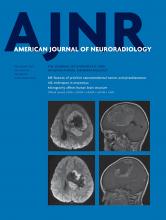Research ArticlePediatric Neuroimaging
Open Access
Diffusion Characteristics of Pediatric Diffuse Midline Gliomas with Histone H3-K27M Mutation Using Apparent Diffusion Coefficient Histogram Analysis
M.S. Aboian, E. Tong, D.A. Solomon, C. Kline, A. Gautam, A. Vardapetyan, B. Tamrazi, Y. Li, C.D. Jordan, E. Felton, B. Weinberg, S. Braunstein, S. Mueller and S. Cha
American Journal of Neuroradiology November 2019, 40 (11) 1804-1810; DOI: https://doi.org/10.3174/ajnr.A6302
M.S. Aboian
aFrom the Department of Radiology and Biomedical Imaging (M.S.A.), Yale School of Medicine, New Haven, Connecticut
E. Tong
bDepartment of Radiology (E.T.), Stanford University, Stanford, California
D.A. Solomon
cDivision of Neuropathology (D.A.S.)
C. Kline
hDivision of Pediatric Hematology/Oncology (C.K., E.F., S.M.), Department of Pediatrics, University of California, San Francisco, California
A. Gautam
iJohns Hopkins University (A.G.), Baltimore, Maryland
A. Vardapetyan
jUniversity of California Berkeley (A.V.), Berkeley, California
B. Tamrazi
kDepartment of Radiology (B.T.), Children's Hospital Los Angeles, Los Angeles, California
Y. Li
dDepartment of Pathology, Departments of Radiology (Y.L., C.D.J., S.C.)
C.D. Jordan
dDepartment of Pathology, Departments of Radiology (Y.L., C.D.J., S.C.)
E. Felton
hDivision of Pediatric Hematology/Oncology (C.K., E.F., S.M.), Department of Pediatrics, University of California, San Francisco, California
B. Weinberg
lDepartment of Neuroradiology (B.W.), Emory University, Atlanta, Georgia
S. Braunstein
eRadiation Oncology (S.B.)
S. Mueller
fNeurological Surgery (S.M.)
gNeurology (S.M.)
hDivision of Pediatric Hematology/Oncology (C.K., E.F., S.M.), Department of Pediatrics, University of California, San Francisco, California
S. Cha
dDepartment of Pathology, Departments of Radiology (Y.L., C.D.J., S.C.)

References
- 1.↵
- 2.↵
- 3.↵
- 4.↵
- 5.↵
- Aboian MS,
- Solomon DA,
- Felton E, et al
- 6.↵
- Rodriguez Gutierrez D,
- Awwad A,
- Meijer L, et al
- 7.↵
- 8.↵
- Nowosielski M,
- Recheis W,
- Goebel G, et al
- 9.↵
- Pope WB,
- Lai A,
- Mehta R, et al
- 10.↵
- Pope WB,
- Kim HJ,
- Huo J, et al
- 11.↵
- Sturm D,
- Witt H,
- Hovestadt V, et al
- 12.↵
- 13.↵
In this issue
American Journal of Neuroradiology
Vol. 40, Issue 11
1 Nov 2019
Advertisement
M.S. Aboian, E. Tong, D.A. Solomon, C. Kline, A. Gautam, A. Vardapetyan, B. Tamrazi, Y. Li, C.D. Jordan, E. Felton, B. Weinberg, S. Braunstein, S. Mueller, S. Cha
Diffusion Characteristics of Pediatric Diffuse Midline Gliomas with Histone H3-K27M Mutation Using Apparent Diffusion Coefficient Histogram Analysis
American Journal of Neuroradiology Nov 2019, 40 (11) 1804-1810; DOI: 10.3174/ajnr.A6302
0 Responses
Diffusion Characteristics of Pediatric Diffuse Midline Gliomas with Histone H3-K27M Mutation Using Apparent Diffusion Coefficient Histogram Analysis
M.S. Aboian, E. Tong, D.A. Solomon, C. Kline, A. Gautam, A. Vardapetyan, B. Tamrazi, Y. Li, C.D. Jordan, E. Felton, B. Weinberg, S. Braunstein, S. Mueller, S. Cha
American Journal of Neuroradiology Nov 2019, 40 (11) 1804-1810; DOI: 10.3174/ajnr.A6302
Jump to section
Related Articles
Cited By...
- Correlation between Multiparametric MR Imaging and Molecular Genetics in Pontine Pediatric High-Grade Glioma
- MR Imaging Characteristics and ADC Histogram Metrics for Differentiating Molecular Subgroups of Pediatric Low-Grade Gliomas
- Brain Abnormalities in Patients with Germline Variants in H3F3: Novel Imaging Findings and Neurologic Symptoms Beyond Somatic Variants and Brain Tumors
- Regional and Volumetric Parameters for Diffusion-Weighted WHO Grade II and III Glioma Genotyping: A Method Comparison
- MR Imaging Correlates for Molecular and Mutational Analyses in Children with Diffuse Intrinsic Pontine Glioma
- Radiological Evaluation of Newly Diagnosed Non-Brainstem Pediatric High-Grade Glioma in the HERBY Phase II Trial
This article has not yet been cited by articles in journals that are participating in Crossref Cited-by Linking.
More in this TOC Section
Similar Articles
Advertisement











